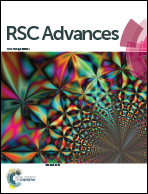Antifungal properties of lecithin- and terbinafine-loaded electrospun poly(ε-caprolactone) nanofibres†
Abstract
The purpose of this article is to investigate the efficacy of electrospun polycaprolactone (PCL) fibres loaded with egg lecithin and terbinafine hydrochloride (terbinafine) against moulds and dermatophytic fungi which are responsible for superficial nail and skin mycoses. Scanning electron microscopy studies indicated that addition of lecithin and terbinafine decreased the average diameter of the PCL nanofibres, improved the wettability of the fibre mats, increased the mechanical properties and displayed pronounced blue fluorescence. Cellular adhesion studies and confocal microscopy images revealed that the PCL mats containing lecithin and terbinafine did not affect cell adhesion and maintained a normal phenotypic shape and viability of the primary human dermal fibroblasts. In vitro antifungal assays demonstrated that terbinafine-loaded mats maintained antifungal efficacy against moulds as well as dermatophytic fungus. Using an ex vivo porcine skin infection model, we showed that the drug-eluting mats resulted in >5 log reduction in the viability of T. mentagrophytes.


 Please wait while we load your content...
Please wait while we load your content...